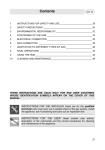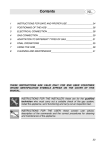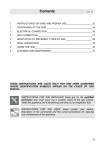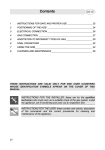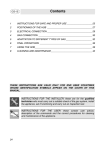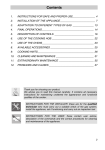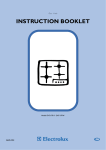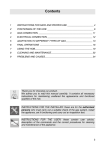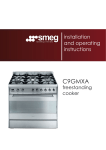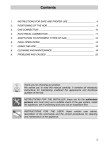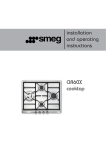Download User manual
Transcript
Contents 1 INSTRUCTIONS FOR SAFE AND PROPER USE _____________________ 4 2 INSTRUCTIONS FOR DISPOSAL – OUR ENVIROMENTAL CARE _______ 7 3 POSITIONING OF THE HOB _____________________________________ 8 4 ELECTRICAL CONNECTION ____________________________________ 13 5 GAS CONNECTION ___________________________________________ 14 6 ADAPTATION TO DIFFERENT TYPES OF GAS _____________________ 16 7 FINAL OPERATIONS __________________________________________ 19 8 USING THE HOB______________________________________________ 22 9 CLEANING AND MAINTENANCE_________________________________ 25 THESE INSTRUCTIONS ARE VALID ONLY FOR END USER COUNTRIES WHOSE IDENTIFICATION SYMBOLS APPEAR ON THE COVER OF THIS MANUAL. INSTRUCTIONS FOR THE INSTALLER: these are intended for the authorized person who is to check the gas supply system and install, commission and test the appliance. INSTRUCTIONS FOR THE USER: these contain user advice, description of the commands and the correct procedures for cleaning and maintenance of the appliance. @ Further product information is available from the website www.smeg.com 3 Precautions for Safety and Use 1 INSTRUCTIONS FOR SAFE AND PROPER USE THIS MANUAL IS AN INTEGRAL PART OF THE APPLIANCE AND THEREFORE MUST BE KEPT IN ITS ENTIRETY AND IN AN ACCESSIBLE PLACE FOR THE WHOLE WORKING LIFE OF THE COOKING HOB. WE ADVISE READING THIS MANUAL AND ALL THE INSTRUCTIONS THEREIN BEFORE USING THE COOKING HOB. ALSO KEEP THE SERIES OF NOZZLES SUPPLIED. INSTALLATION MUST BE CARRIED OUT BY QUALIFIED PERSONNEL IN ACCORDANCE WITH THE REGULATIONS IN FORCE. THIS APPLIANCE IS INTENDED FOR DOMESTIC USES AND CONFORMS TO CURRENT REGULATIONS IN FORCE. THE APPLIANCE HAS BEEN BUILT TO CARRY OUT THE FOLLOWING FUNCTIONS: COOKING AND HEATING-UP OF FOOD. ALL OTHER USES ARE CONSIDERED IMPROPER. THE MANUFACTURER DECLINES ALL RESPONSIBILITY FOR IMPROPER USE. THIS APPLIANCE HAS BEEN MANUFACTURED TO COOK FOOD, DO NOT USE THE APPLIANCE TO HEAT ROOMS. TO BE INSTALLED ONLY BY AN AUTHORIZED PERSON. NEVER LEAVE PACKAGING RESIDUES UNATTENDED IN THE HOME. SEPARATE WASTE PACKAGING MATERIALS BY TYPE AND CONSIGN THEM TO THE NEAREST SEPARATE DISPOSAL CENTRE. REPLACED APPLIANCES MUST BE TAKEN TO A SPECIAL GARBAGE COLLECTION CENTRE. THE APPLIANCE MUST BE CONNECTED TO EARTH IN COMPLIANCE WITH ELECTRICAL SYSTEM SAFETY REGULATIONS. THE PLUG TO BE CONNECTED TO THE POWER SUPPLY LEAD AND THE RELATIVE SOCKET MUST BE OF THE SAME TYPE AND COMPLY WITH THE RELEVANT REGULATIONS. THE SOCKET MUST BE ACCESSIBLE AFTER THE APPLIANCE IS BUILT IN. NEVER DISCONNECT THE PLUG BY PULLING ON THE POWER SUPPLY LEAD. 4 Precautions for Safety and Use IMMEDIATELY AFTER INSTALLATION, CARRY OUT A QUICK TEST ON THE APPLIANCE FOLLOWING THE INSTRUCTIONS PROVIDED LATER IN THIS MANUAL. SHOULD THE APPLIANCE NOT FUNCTION, DISCONNECT IT FROM THE SUPPLY AND CALL THE NEAREST TECHNICAL ASSISTANCE CENTRE. NEVER ATTEMPT TO REPAIR THE APPLIANCE YOURSELF. AFTER EACH USE OF THE APPLIACE, ALWAYS CHECK THAT THE CONTROL KNOBS ARE TURNED TO OFF NEVER PLACE FLAMMABLE OBJECTS IN THE OVEN: IF IT SHOULD ACCIDENTALLY BE SWITCHED ON, THIS MIGHT CAUSE A FIRE. THE IDENTIFICATION PLATE, WITH TECHNICAL DATA, SERIAL NUMBER AND MARKING IS CLEARLY VISIBLE UNDER THE CASING. THE PLATE ON THE CASING MUST NOT BE REMOVED. BEFORE CONNECTING THE DEVICE, MAKE SURE THAT IT HAS BEEN REGULATED FOR THE TYPE OF GAS THAT WILL FEED IT, CHECKING THE LABEL UNDER THE HOB. NEVER PLACE PANS WITH BOTTOMS WHICH PERFECTLY FLAT AND SMOOTH ON THE HOB GRIDS. ARE NOT DURING USE THE APPLIANCE BECOMES VERY HOT. TAKE CARE NEVER TO TOUCH THE HEATING ELEMENTS INSIDE THE OVEN. TO AVOID BURNS AND SCALDS CHILDREN SHOULD BE KEPT AWAY. INSTALL THE APPLIANCE SO THAT WHEN DRAWERS OR DOORS OF UNITS INSTALLED AT HOB HEIGHT ARE OPENED, ACCIDENTAL CONTACT WITH PANS ON THE HOB IS NOT POSSIBLE. WARNING - IN ORDER TO PREVENT ACCIDENTAL TIPPING OF THE APPLIANCE, FOR EXAMPLE BY A CHILD CLIMBING ONTO THE OPEN OVEN DOOR, THE STABILIZING MEANS MUST BE INSTALLED. PLEASE REFER TO INSTRUCTIONS FOR INSTALLATION. NEVER USE PANS OR GRIDDLE PLATES WHICH PROJECT BEYOND THE OUTSIDE EDGE OF THE HOB. 5 Precautions for Safety and Use THE APPLIANCE IS NOT INTENDED FOR USE BY YOUNG CHILDREN OR INFIRM PERSONS UNLESS THEY HAVE BEEN ADEQUATELY SUPERVISED BY A RESPONSIBLE PERSON TO ENSURE THEY CAN USE THE APPLIANCE SAFELY. YOUNG CHILDREN SHOULD BE SUPERVISED TO ENSURE THAT THEY DO NOT PLAY WITH THE APPLIANCE. DO NOT SPRAY ANY SPRAY PRODUCTS NEAR THE ELECTRICAL APPLIANCE WHILE IT IS IN OPERATION. DO NOT USE SPRAY PRODUCTS WHILE THE PRODUCT IS STILL HOT. WHERE THIS APPLIANCE IS INSTALLED IN MARINE CRAFT OR CARAVANS, IT SHALL NOT BE USED AS A SPACE HEATER. DO NOT MODIFY THIS APPLIANCE. DO NOT USE STEAM JETS FOR CLEANING THE APPLIANCE. THE STEAM COULD REACH THE ELECTRONICS, DAMAGING THEM AND CAUSING SHORT-CIRCUITS. DO NOT STORE FLAMMABLE MATERIALS IN THE APPLIANCE STORAGE DRAWER OR NEAR THIS APPLIANCE. THE INSTRUCTIONS PACKAGED WITH THIS APPLIANCE CONTAIN IMPORTANT INFORMATION ABOUT INSTALLATION AND USE. UNSUITABLE FOR USE IN MARINE CRAFT, CARAVANS OR MOBILE HOMES, UNLESS EACH BURNER IS FITTED WITH A FLAME SAFEGUARD IN CASE OF SERVICE, CONTACT YOUR NEAREST SERVICE AGENT OR DISTRIBUTOR LISTED ON THE WARRANTY CARD. The manufacturer declines all responsibility for injury or damage caused by failure to comply with the above regulations or deriving from tampering with even just one part of the appliance and the use of nonoriginal spare parts. 6 Instructions for disposal 2 ENVIROMENTAL RESPONSIBILITY Our product's packing is made of non-polluting materials, which are therefore compatible with the environment and recyclable. Please help by disposing of the packaging correctly. You can obtain the addresses of collection, recycling and disposal centres from your retailer or from the competent local organisations. Do not discard the packaging or any part of it, or leave it unattended. It can constitute a suffocation hazard for children, especially the plastic bags. Your old appliance also needs to be disposed of correctly. Important: hand over your appliance to the local agency authorised for the collection of electrical appliances no longer in use. Correct disposal enables intelligent recovery of valuable materials. Before disposing of your appliance it is important to remove doors and leave shelves in the same position as for use, to ensure that children cannot accidentally become trapped inside during play. It is also necessary to cut the connecting cable to the power grid, removing it along with the plug. 7 Instructions for the Installer 3 POSITIONING OF THE HOB It is the law that all gas appliances are installed by authorised persons. Clearance around the appliance must comply with the requirements of AS5601. The following operation requires building and/or carpentry work so must be carried out by a competent tradesman. Installation can be carried out on various materials such as masonry, metal, solid wood or plastic laminated wood as long as they are heat resistant (T 90°C). 3.1 Attachment to support structure Create an opening with the dimensions shown in the figure in the top surface of the counter, keeping a minimum distance of 50 mm from the rear border. This appliance is classified as “type Y” in relation to fire hazards and can therefore be mounted against walls higher than the work surface on condition that a certain distance “X” be kept between the appliance and the wall as shown in the figure so as to avoid damage from overheating. Make sure there is a minimum of 750 mm between the hot plate flames and any shelf that may be installed directly above them. Carefully position the insulating seal supplied on the outer perimeter of the hole made in the counter top as shown in figure 4 (the dimensions in the figure refer from the hole to the inside of the seal), trying to ensure that it sticks across the whole of its surface by applying light pressure with your hands. Fix the hob to the unit using the appropriate brackets B and spacer A as shown in figures 1, 2 and 3. Spacer A will help to keep the hob top at the right distance from the edge of the counter top to avoid future overheating during operation and must be used solely in the front left-hand corner of the appliance. Carefully trim the surplus away from edge C beyond the seal (Fig.5). 8 Instructions for the Installer B B 20 ÷ 40 A+B A B B B B Fig.1 Fig.2 A B Fig.3 Fig.4 Fig.5 9 Instructions for the Installer Overall dimensions: location of gas and electrical connection points (all measures in mm). A B C D A B C D 60 cm hob 35 65 30 80 3.2 Clearances above and around domestic appliances Extract from AS5601 10 90 cm hob 105 50 50 75 Instructions for the Installer REQUIREMENTS 1. Overhead clearances – (Measurement A) Range hoods and exhaust fans shall be installed in accordance with the manufacturer’s instructions. However, in no case shall the clearance between the highest part of the hob of the cooking appliance and a range hood be less than 600 mm or, for an overhead exhaust fan, 750 mm. Any other downward facing combustible surface less than 600 mm above the highest part of the hob shall be protected for the full width and depth of the cooking surface area in accordance with Clause 5.12.1.2. However, in no case shall this clearance to any surface be less than 450 mm. 2. Side clearances – (Measurements B & C) Where B, measured from the periphery of the nearest burner to any vertical combustible surface, is less than 200 mm, the surface shall be protected in accordance with Clause 5.12.1.2 to a height C of not less than 150 mm above the hob for the full dimension (width or depth) of the cooking surface area. Where the cooking appliance is fitted with a ‘splashback’, protection of the rear wall is not required. 3. Additional requirements for Freestanding and Elevated Cooking Appliaces – (Measurements D & E) Where D, the distance from the periphery of the nearest burner to a horizontal combustible surface is less than 200 mm, then E shall be 10 mm or more, or the horizontal surface shall be above the trivet. See insets above. 11 Instructions for the Installer NOTES 1. Requirement 3 does not apply to a freestanding or elevated cooking appliance which is designed to prevent flames or the cooking vessels from extending beyond the periphery of the appliance. 2. The ‘cooking surface area’ is defined as that part of the appliance 3. where cooking normally takes place and does not include those parts of the appliance containing control knobs. 4. For definition of hob, see Clause 1.4.64. 5. For definition of trivet, see Clause 1.4.109. 6. Consideration is to be given to window treatments when located near cooking appliances. See Clause 5.3.4. 12 Instructions for the Installer 4 ELECTRICAL CONNECTION Make sure that the voltage and capacity of the power line conform to the data shown on the plate located under the casing. Do not remove this plate for any reason. The plug on the end of the supply cable and the wall socket must be the same type and conform to the current electrical system regulations. Check that the power line is adequately grounded. On the power line, install an omnipolar cut-off device with contact cutoff distance greater than or equal to 3 mm, located in an easily accessible position near the unit. Do not use reducers, adapters or shunts. If the power cable is replaced, the wire section on the new cable must not be less than 1 mm 2 (3 x 1 cable), keeping in mind that the end to be connected to the hob must have the ground wire (yellow-green) longer by at least 20 mm. Use only H05V2V2-F cable or similar which has a maximum temperature of 90°C. Any replacement needed should be carried out by a specialised technician who should make the mains connections according to the following diagram. L = brown N = blue = yellow-green The manufacturer will not be liable for any damage to persons or property caused by non-observance of the above instructions or deriving from the tampering of even a single part of the hob. 13 Instructions for the Installer 5 GAS CONNECTION This appliance is suitable for installation with Natural Gas or ULPG (propane/butane). Refer to page 12 for the relevant burner pressure and appropriate injector sizes. When the appliance is to be connected to Natural Gas then the pressure regulator supplied must be fitted to the gas inlet. A test point (for checking the gas pressure) is supplied either with the regulator or as a separate fitting in the case of ULPG (propane/butane) appliances. Connection of the appliance to the gas supply must be in accordance with the requirements of AS5601. A ½” BSP connector at the inlet is recommended and the gas supply line to the appliance must be of adequate length to allow sufficient withdrawal of appliance for service or disconnection and be: 1. annealed copper pipe or; 2. flexible hose according to AS/NZ1869 & be at least Class “B”, 10 mm diameter. The appliance must be installed with provision to allow the gas to be turned off and disconnected for servicing and removal of the appliance as required from the gas supply. Before the appliance is operated make certain all relevant parts are placed in the correct position. When the installation is completed the installation connections of appliance will require to be leak tested, the burner operating pressure and flame checked and adjusted. Warranty service calls do not cover these adjustments! To check the operating pressure of the appliance it is recommended at least 2 large size burners are used. Ensure appliance is secured to wall when installation is completed. N.G. The regulator supplied must be fitted to the ½ BSP thread at the rear of the appliance. An approved manual shut-off valve must be installed. The N.G. regulator must be checked and adjusted to 1.0kPa after installation. U.L.P.G. Can be connected to the inlet fitting directly. The pressure must be checked to ensure it is operating at 2.75kPa. A separate test point fitting must be installed between the piping & the appliance for the pressure to be checked to ensure it is operating at 2.75kPa. Installation with the flexible hose must be carried out so that the length of the piping does not exceed 2 metres fully extended; make sure that the hoses do not come into contact with moving parts and that they are not crushed in any way. 14 Instructions for the Installer 5.1 Connection to liquid gas Use a pressure regulator and make the connection on the gas cylinder following the guidelines established by the regulations in force. Make sure that the feed pressure complies with the values indicated in the table at point “5.3 Burner and nozzle characteristics table”. 5.2 Room ventilation Caution – This hob may only be installed and operated in rooms permanently ventilated in accordance with current regulations. For proper operation of a gas appliance it is essential for the air necessary for combustion of the gas to be able to flow naturally into the room. Air must flow directly into the room through openings in its outside walls. This (these) opening (s) must have a free passage cross-section of at least 100 cm2, or 200 cm2 for appliances not equipped with gas safety device. These openings must be constructed so that they cannot be obstructed indoors or outdoors, and should preferably be close to the floor on the side opposite to the combustion gas discharge point. If it is not possible to make the openings in the room where the cooker is installed, the necessary air may be taken from an adjoining room, proveded it is not a bedroom or a room with fire risk. 5.3 Combustion discharge Combustion gases may be discharged by means of hoods connected to a flue with reliable natural draught, or a fan extraction system. An effective extraction system requires careful design by an authorised specialist, and must comply with the regulation distances and positions. After installation, the engineer must issue a certificate of compliance. 15 Instructions for the Installer 6 ADAPTATION TO DIFFERENT TYPES OF GAS Before performing any cleaning or maintenance work, disconnect the appliance from the electrical socket. The hob has been adjusted for natural gas at a pressure of 1.0 kPa. For functioning with other types of gas the nozzles must be replaced and the primary air adjusted. To replace the nozzles and regulate the burners, you have to remove the top as described in the following paragraph. 6.1 1. 2. 3. 4. 6.2 1. 2. 3. 16 Removing the separable control panel (models with separable control panel) Remove the knobs and the knob guard tube “A” by pulling them up; Use a crosshead screwdriver to remove the screws and the two cylindrical supports “B”; Raise the left-hand side of the control panel slightly and shift it to the right to remove it completely; In models with electric hotplate, the body of the pilot light has to be removed to free the control panel; Removing the hob (models with integrated control panel) Remove the knobs, the griddles, the burner caps, the flame caps and the two rear plugs; Remove the screws “A” which fix the burner supports; Raise the hob, sliding it off the ignition plugs and/or the thermocouples and the gas tap rods; Instructions for the Installer 6.3 Adjustment for ULPG Check that the connection has been made as described in the “Gas connection” section. Undo the screw “D” and push the air regulator “C” fully down. Use a spanner to remove the nozzles “B” and fit those of suitable type following the instructions given in the tables for bottled gas ULPG 2.75 kPa. The nozzle must not be tightened to a torque of over 3 Nm. Burner Auxiliary Semi rapid Rapid Rapid Large Fish Pan Wok ULPG – 2.75 kPa Nominal gas consumption (MJ/h) 4.8 5.9 8.6 9.5 9.5 15.0 Injector (mm) 0.60 0.65 0.78 0.85 0.85 1.05 17 Instructions for the Installer 6.4 Regulation for natural gas The hob has been adjusted for natural gas at a pressure of 1.0kPa. To allow the unit to work back with this type of gas, after it has been adjusted for ULPG, perform the same operations described in paragraph “5.3 Adjustment for ULPG”, but refer to the following table for the proper injectors. Burner Auxiliary Semi rapid Rapid Rapid Large Fish Pan Wok 18 NG – 1.0 kPa Nominal gas consumption (MJ/h) 4.8 5.9 8.6 11.4 11.4 15.0 Injector (mm) 0.98 1.10 1.25 1.50 1.50 1.70 Instructions for the Installer 7 FINAL OPERATIONS Having carried out the above adjustments, reassemble the appliance following, backwards, the instructions in paragraph “5.1 Removing the separable control panel / 5.2 Removing the hob”. 7.1 Regulation of minimum for natural gas Light the burner and take it to the minimum . Remove the gas tap knob and turn the adjustment screw at the side of the tap shaft until there is a regular minimum flame. Replace the knob and check burner flame stability: (rapidly turning the knob from maximum to minimum position, the flame should not go out). Repeat the operation on all the gas taps. 19 Instructions for the Installer 7.2 Arrangement of the burners on the hob (Hob with separable control panel) 60 cm. hob BURNERS 1. 2. 3. 4. 5. Auxiliary Semirapid r Semirapid l Rapid large Wok 90 cm. hob BURNERS 1. 2. 3. 4. 5. 20 Auxiliary Semirapid Rapid Fish burner Wok Instructions for the Installer 7.3 Arrangement of the burners on the hob (Hob with built-in control panel). 60 cm. hob BURNERS 1. 2. 3. 4. 5. 7.4 Auxiliary Semirapid r Semirapid l Rapid Wok Lubrication of gas taps With time it may happen that the gas taps get blocked and hard to turn. Clean them inside and re-grease them. This operation must be done by an authorised person. 21 Instructions for the user 8 USING THE HOB Before turning on the burners, make sure that the burner rings, caps and grids have been fitted correctly. In the ultrarapid burner, notch A must be aligned with pin B. Grid C provided is intended for use with woks (Chinese pans). Adapter D comes only with open grids models and is intended for use with small sized vessels. 8.1 Ignition of the burners The device is fit with electronic ignition. Simply press and simultaneously turn the knob counter-clockwise on the low point flame symbol, until the burner is ignited. In models with safety valve, the knob has to be turned to the ignition symbol before it is pressed, and after ignition the knob has to be kept pressed for about 2 seconds to keep the flame lit and to activate the safety device. The burner might go off when the knob is released. In this case repeat the aforesaid operation keeping the knob pressed for more than 2 seconds. Should the burners go off accidentally in the models with valves, a safety device will trip after approximately 20 seconds to block the gas outlet even if the cock is open. 8.2 Practical advice for using the burners For better burner performance and minimum gas consumption, flat bottomed, even pans must be used, with covers and proportional in size to the burners (see paragraph “7.3 Diameter of the pans”). To avoid overcooking or damage to the surface top 22 Instructions for the user while cooking, all pans or griddles must be positioned within the cooking hob perimeter and must be a minimum distance of 3-4 cm from the knobs. 8.3 Diameter of the pans Burners Ø min. and max. (en cm.) Auxiliary 12-14 Semirapid 16-20 Rapid medio 22-26 Rapid large 22-26 Ultrarapid 22-26 Fish burner 8.4 Special oval-shaped vessels Electric elements 8.4.1 Turning on electric elements Hobs may be fitted with an electric element of varying diameter. The electric element is controlled by a switch and is turned on by rotating the appropriate knob to the desired position. 8.4.2 Using the electric elements The settings shown in the table are merely indicative. POSITION HEAT INTENSITY POSSIBLE COOKING 0 Off 1 Wreak To melt butter, chocolate, etc. To heat small amounts of liquid. 2 Soft To heat larger amounts of liquid. 3 Slow To defrost frozen food and prepare stews, cooking at or just below boiling point. 23 Instructions for the user 4 Medium To cook food which has to reach boiling point, to roast delicate meat or fish. 5 Strong For roasts, steaks and large boiled joints. 6 Very strong To boil large amounts of water, to fry. WARNING When switching on the electric element for the first time, or if the electric element has not been used for a long time, to remove any humidity from the insulating material it should be dried out by placing the electric element on position 1 for 30 minutes. To use correctly remember to: • Switch the electric element only after having placed the pan on it. • Use flat and thick bottomed pans. • Never use pans which are smaller than the electric element. • Dry the bottom of the pan before placing it on the electric element. • When cooking with flammable oils and fats, never leave the appliance. • The electric elements will stay hot for a long time after use: do not touch them or place any objects on them. • If any dents appear in the electric element surface, switch it off immediately and contact the nearest authorised servicing centre. • Never place sheets of aluminium foil directly on the surface of the hotplate. 24 Instructions for the user 9 CLEANING AND MAINTENANCE Never use a steam jet to clean the appliance. Before any intervention, disconnect the power supply of the device. 9.1 Cleaning Clean the cooking top regularly every time you use it, obviously after it has cooled. 9.1.1 Regular daily cleaning of the hob In order to clean and preserve the surface, always use specific products only, which do not contain abrasive substances or chlorinebased acid substances. How to use: pour the product on a damp cloth and wipe the surface, rinse thoroughly and dry with a soft cloth or deerskin. 9.1.2 Food stains or residues Do not use metallic sponges or sharp scrapers: they will damage the surface. Use normal non-abrasive products and remove spots or residuals with non-scratch sponges or, if need be, with wood or plastic utensils. Rinse thoroughly and dry with a soft cloth or deerskin. 25 Instructions for the user 9.2 Cleaning of cooking hob components CAUTION: do not wash these components in a dishwasher. In normal use of the hob, the stainless steel burner caps and panstands tend to be burnished by the high temperature. Clean these parts using very fine abrasive sponges or similar commercial products. Then use a specific paste polish to restore the steel’s shine. Your local authorised after-sales technician is able to supply professional products for appliance cleaning and care. Grids, caps, flame cap crowns and burners can be removed for ease of cleaning. Wash them in warm water using a non-abrasive detergent, taking care to remove all tough spots. Before remounting, allow the components to fully dry out. In fact, humidity residues inside the burner holes might impair burner operation. 9.2.1 Ignition plugs and safety devices For good functioning of the lighting ignition plugs and the safety devices, keep them very clean. Check frequently and clean with a damp cloth when necessary. 9.2.2 The electric element After use, to make sure that the surfaces are clean and long lasting, the electric element must be treated with specific cleaning products which are available on the market. This necessary operation prevents oxidisation (rust formation). 9.2.3 The cover Clean the glass or steel cover, where mounted, with warm water. Never use abrasive sponges or detergents. Never lower the cover when burners or electric elements are on or still hot. Attention: the glass lid may break if overheated. Make sure that all the burners are switched off and let them cool down before lovering the lid. 26 Instructions for the user 9.2.4 Preventive maintenance This appliance does not need any special maintenance. However, a few simple operations have to be carried out periodically to prevent malfunctioning: Burners: the burners must be cleaned periodically to ensure correct combustion; make sure that all the openings and flame ports are clean and free of obstacles, and that the burners rest firmly on their supports. Gas connection: the gas connection must be checked periodically. Flexible pipes: if a flexible pipe is used, it must be inspected periodically (once a year) for leakages: if the surface of the pipe appears rigid and cracked, disconnect immediately the cooker from the gas supply and replace the pipe with a new one. Valves: if the gas valves get stuck or hard to turn, they need to be cleaned and re-greased; this operation must be carried out by an authorised person. 27 Instructions for the user 9.3 PROBLEMS AND CAUSES Each of the following cases is caused by an abnormal operation of the appliance and should be dealt with by a authorised persons: please contact your local dealer or Service Center in case you detect any of these malfunctioning. PROBLEM The flame is very long with bright yellow tips. Black deposits on the bottom of the pans. The flame is very short and noisy. The flame moves away from the burner ports. The flame extinguishes when the burner knob is set to the low flame position. The valve knob is hard to rotate. 28 CAUSE Defect of comburent air or incorrect injectors. Burner dirty or flame ports obstructed. Excess of comburent air. WHAT TO DO Clean the burner. Call Service Center if the problem remains. Call Service Center. Incorrect adjustment of the Call Service Center. minimum heat input or excess of comburent air. Gas valve worn out or Call Service Center. needs lubrification. 914773237/ E




























